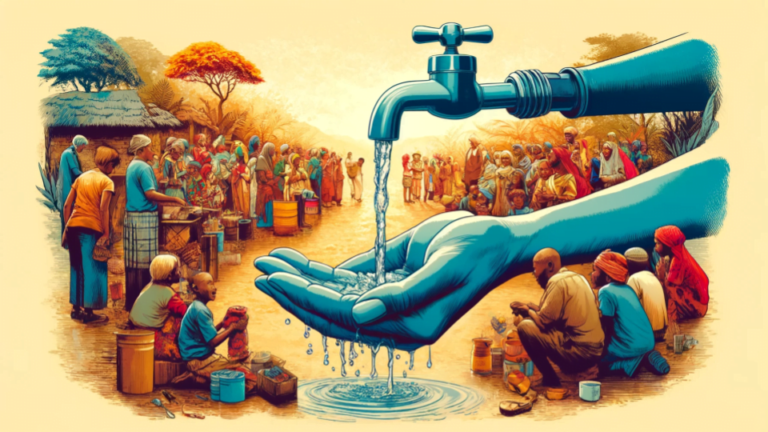Sarvagram : Quietly Rewriting the Rules of Rural Finance

This startup is quietly transforming rural India, and it’s about time we gave them a shoutout at Venture Kites. Founded in 2018 by Utpal Isser and Sameer Mishra, this Pune-based startup uplifts the rural and semi-urban population through tailored financial solutions. Sarvagram is on a mission to bridge the gap between rural households and access to financial services. (Sarvagram)
In an industry dominated by traditional systems, Sarvagram is carving out a unique space by using technology and local partnerships. Sarvagram provides small business loans, agricultural financing, and other essential credit products to underbanked communities. By leveraging both digital platforms and a high-touch service model, the company makes credit more accessible, thus empowering rural families to boost their incomes and improve their livelihoods.
Sarvagram operates through a network of local agents, called Sarvamitras, who ensure that financial services are accessible even in remote locations. With over 125 branches across states like Gujarat, Maharashtra, and Rajasthan, Sarvagram aims to not just expand credit but also to make a meaningful impact on rural lives. Their efforts have been recognized by major investors like Temasek, Elevar Equity, and many others.
From the Ground Up: Meet the Minds Behind Sarvagram
SarvaGram, co-founded by Utpal Isser and Sameer Mishra, is revolutionizing rural India’s financial landscape. Their experience and dedication to empowering rural households have shaped SarvaGram into a cutting-edge platform. Here’s a look at the founders and the story behind SarvaGram.
Utpal Isser – Co-Founder, MD & CEO
Utpal Isser has spent over 20 years understanding the complexities of rural India. His education at the Institute of Rural Management Anand (IRMA) equipped him with a strong foundation to navigate rural economies and livelihoods. During his 18-year tenure at ICICI Bank, Utpal launched several products tailored to the needs of rural customers, including farmers, self-employed individuals, and micro-enterprises. His deep knowledge of rural financial services has been instrumental in shaping SarvaGram’s high-tech, high-touch platform. (Utpal Isser)
Sameer Mishra – Co-Founder, ED & Business Head
Sameer Mishra has been driven by his passion for rural financial services for nearly two decades. Before co-founding SarvaGram, he played a key role in developing the rural finance arm of Adani Capital. Sameer also spent ten years at Fullerton India, where he led the rural business after rising through the ranks. His belief in accessible financial services for underserved communities inspired the creation of SarvaGram. Sameer holds a bachelor’s degree in science and a master’s in business management from Kanpur University. (Sameer Mishra)
The Founding Story
Together, the two founders realized the potential of India’s rural economy, which had been largely overlooked by traditional banks. SarvaGram was founded in 2019 with a mission to meet the growing aspirations of rural India. Utpal and Sameer combined their vast experience to create a platform that brings tailored financial solutions to rural households. SarvaGram started by offering “Farming as a Service” and opened nine “Shoppes” across India. The business grew quickly, reaching 50 Shoppes by 2022 and expanding its services to Rajasthan and Karnataka. By 2023, SarvaGram operated 67 Shoppes and secured investments from Temasek and TVS Capital Funds. In 2024, the company celebrated the opening of its 124th Shoppe and expanded to Telangana, adding retail insurance to its offerings. Today, Sarvagram operates with a unique high-touch, high-tech model, combining data-driven insights with a robust on-ground presence to serve over 80 million households.
Small Loans, Big Impact: Microfinance’s Growing Field
Microfinance is the silent force driving India’s financial inclusion revolution. In recent years, this sector has expanded dramatically, providing essential credit to millions who lack access to traditional banking services. By offering small, unsecured loans, microfinance institutions (MFIs) empower low-income households and micro-entrepreneurs to improve their living standards, start businesses, or manage essential expenses.
India’s microfinance market was valued at $46.13 billion in 2023 and is growing at a rate of 7.2%. As of May 2023, the sector served 7 crore borrowers through more than 13 crore loan accounts. The industry saw a 19.5% increase in its loan portfolio over the previous year, highlighting its role in supporting underbanked segments of the population. (Techsci Research)
The East and Northeast regions dominate the microfinance landscape, with states like Bihar and Tamil Nadu leading in loan portfolios. Key players include banks, NBFC-MFIs (Non-Banking Financial Companies focused on microfinance), and small finance banks (SFBs). NBFC-MFIs hold the largest share, with a 40.6% stake in the total loan portfolio, followed by banks with 32.5%. (MFIN India)
The increasing use of mobile banking technologies and digital platforms has allowed MFIs to expand their reach, reducing costs and improving efficiency. Platforms like the Bharat Bill Payment System (BBPS) and Aadhaar-enabled payments have made disbursements and repayments more seamless.
Despite its successes, the sector faces challenges, including high interest rates (ranging from 12% to 30%) and issues of over-indebtedness as borrowers take multiple loans. The need for financial literacy and the competition from traditional banks are other hurdles for MFIs. Nevertheless, with a growing focus on digitization and partnerships with fintech firms, the microfinance market is poised for further growth in the coming years.
Mission Possible: Sarvagram’s Vision for a Better Tomorrow
Mission and Vision
Sarvagram’s mission is to empower rural India by enabling aspirations through easy access to credit and distribution services. Their vision revolves around addressing the financial exclusion faced by rural households, ensuring that creditworthy yet underserved segments gain access to financial solutions. (About Sarvagram)
Problems They Solve
The core problem Sarvagram addresses is the financial exclusion of rural households. Traditional banks often overlook these populations due to non-standardized documentation and the complexity of multiple income streams. Sarvagram steps in to fill this gap by offering loans tailored to the needs of rural borrowers, from agriculture to small businesses. They also tackle issues like income variability and lack of formal credit histories.
Business Model
Sarvagram operates a high-touch, high-tech business model. This combines data-driven insights with a strong on-ground presence through their franchise network, SarvaMitras. They assess households’ economic potential by analyzing income variability and multiple streams, allowing for more personalized credit solutions. Their model not only provides credit but also incorporates farm mechanization and other capacity-enhancing services.
Money in Motion: Sarvagram’s Full Suite of Solutions
Sarvagram’s product portfolio is as dynamic as rural India’s growing financial needs. They offer a range of loan products tailored to empower underbanked households in rural and semi-urban areas. From business loans to farm mechanization services, Sarvagram provides the right financial tools to help these communities grow.
Diverse Loan Products
Sarvagram provides a range of loan options, including (Sarvagram Loans):
- Farm Loans: These loans cover everything from purchasing farm equipment to maintaining livestock. Loan amounts can go up to ₹25 lakhs, with flexible tenures ranging from 36 to 72 months.
- Business Loans: Targeted at small and medium enterprises (SMEs) in rural areas, Sarvagram offers business loans with amounts up to ₹25 lakhs. Borrowers can get these loans without collateral for amounts up to ₹3 lakhs, making it easier for small businesses to access credit.
- Personal Loans: Designed for emergencies and personal use, these loans offer flexibility and easy documentation. Loan amounts range from ₹1 lakh to ₹5 lakhs.
- Gold Loans: Sarvagram also provides gold loans for those in immediate need of cash. These loans are processed quickly, ensuring funds are available without delay.
- Home Loans: Helping rural families achieve homeownership, Sarvagram offers home loans for construction, renovation, or purchase. Like other products, loan amounts can reach ₹25 lakhs, with flexible repayment options.
- Consumer Durable Loans: For households looking to purchase home appliances, Sarvagram offers consumer durable loans, with no-cost EMI options. Loan amounts range from ₹10,000 to ₹50,000, and the process is streamlined with minimal documentation.
Farm Mechanization and Services
Beyond loans, Sarvagram has ventured into farm mechanization, providing services that help automate farming processes. By reducing the reliance on manual labor, they enhance farm productivity. This includes renting out farming equipment, which is often a barrier for many small-scale farmers. (Farm Services)
Distribution and Franchise Model
Sarvagram’s SarvaMitra franchisee network plays a vital role in their on-ground operations. These franchises bring last-mile delivery of services like credit products and farm rentals to rural areas. With over 250 SarvaMitras across India, Sarvagram ensures rural households have easy access to financial services.
In addition to financial products, Sarvagram offers retail insurance, helping rural households mitigate risks through health, life, and asset insurance solutions. (Insurance)
Tech Meets Touch: The Sarvagram Way
Sarvagram combines high-tech and high-touch methods to reach rural households. They use technology to streamline lending while maintaining a personal, on-ground presence through their SarvaMitra franchisees.
Data-Driven Lending
Sarvagram takes a data-centric approach to assess the financial potential of households. They gather data on household incomes, multiple income streams, and the variability in rural earnings. This helps them provide tailored financial solutions, even for households that lack formal credit histories.
Franchise Model: SarvaMitra
Sarvagram’s SarvaMitra network plays a critical role. These local franchisees are the company’s link to rural customers, providing last-mile delivery of loans and farm mechanization services. By using a network of over 250 SarvaMitras, Sarvagram ensures that even remote areas have access to credit.
Automated Lending and Collection
To manage loan disbursement and collection efficiently, Sarvagram has implemented a SaaS platform that automates loan processes. Most of their loans are repaid using E-NACH, a digital payment system set up by NPCI. This technology integration ensures smoother transactions and better credit management.
It Takes a Village: Building Networks for Financial Success
Sarvagram has made a massive impact in rural India, proving that financial inclusion can transform lives. Since its launch in 2019, the company has provided critical financial products to more than 20,000 rural households across 8,000+ villages. By offering personalized loans and farm mechanization services, Sarvagram has helped boost agricultural productivity and economic growth in underbanked areas. Their 80% female borrower base is a testament to their role in empowering women in these communities.
The company’s proprietary algorithms assess households’ income variability and multiple income streams, allowing for more accurate credit assessments, even when traditional credit documentation is lacking. This approach has allowed them to maintain a tight credit quality while growing their Assets Under Management (AUM) to ₹275 crore by 2024.
One of Sarvagram’s key collaborations is with Northern Arc, IDFC First Bank, Vivriti Capital, AU Small Finance Bank, and UC Inclusive Credit. These partnerships support their lending operations by providing the capital needed to extend loans to underserved communities. Another major collaboration involves the SarvaMitra network, which plays a crucial role in Sarvagram’s distribution model. The 250+ SarvaMitra franchisees are responsible for providing last-mile delivery of loans and farm mechanization services across rural India.
Financial Fuel : Sarvagram’s Growing Revenue Tree
Sarvagram’s funding journey has been impressive, attracting investments from major players in the financial world. (Tracxn)
- Series C (March 30, 2024): Sarvagram secured $1.8M at a valuation of $113.0M. This round was backed by TVS Capital Funds and aimed at further strengthening their distribution network and technological infrastructure.
- Series C (September 30, 2022): This was a larger round where they raised $35M at a valuation of $93.5M. The round saw participation from TVS Capital Funds, Elevar Equity, Elevation Capital, and Temasek. Angel investor Goutam Sanyal also played a part, with INDUSLAW acting as facilitators.
- Conventional Debt (March 30, 2022): Sarvagram raised $396K in a debt round, facilitated by Vivriti Asset Management. This funding helped boost their working capital and operational capacity.
- Series B (September 30, 2021): In this round, Sarvagram raised $152K at a valuation of $29.4M. Alteria Capital was the key investor here, providing the necessary capital for early-stage scaling.
- Series B (January 27, 2021): Sarvagram raised $10.6M at a valuation of $29.7M, with major backing from Elevation Capital and Elevar Equity.
- Seed Round (September 6, 2019): They raised $3.6M in their seed funding at a valuation of $10.9M, with Elevar Equity as the primary investor.
Revenue Growth
Sarvagram’s revenue has seen substantial growth. For FY 2023-24, their revenue is estimated at $19M, up from $8.8M in the previous fiscal year. This marks a significant jump from their earlier revenues.
Big ideas start with bold actions. Sarvagram is proving that innovation in finance can transform rural lives. With its high-tech, high-touch approach, Sarvagram is helping rural households access the financial tools they need to grow. From expanding their distribution network to using data-driven insights, Sarvagram’s journey showcases how startups can drive meaningful change.
Sarvagram is transforming rural India, one household at a time. By focusing on financial inclusion, they provide much-needed credit solutions to underserved communities. Their innovative model blends technology with local knowledge, ensuring even the most remote villages have access to financial services.
Their success lies in a well-executed strategy—using data-driven insights and on-ground partnerships like their SarvaMitra network. This ensures personalized financial products, tailored to the unique needs of rural households, be it agricultural loans or small business financing.
Have a great idea of your own? Now is the time to act on it! Don’t let it sit idle. Take a cue from Sarvagram’s success and work toward turning your vision into reality. For more inspiring stories about groundbreaking startups and business innovations, be sure to check out other articles on Venture Kites. Keep exploring, keep creating!
At a Glance with DORK Company

Dive In with Venture Kites
Lessons From Sarvagram
Leverage Technology for Scalability
The Lesson & Why it matters: Technology can be the backbone of a scalable business, allowing companies to reach more customers efficiently.
Implementation: Invest in tech infrastructure early. Use it to automate processes, improve data analytics, and enhance user experience.
How Sarvagram implements it: Sarvagram uses a SaaS platform to digitize loan processes, making lending more efficient and scalable. This tech-first approach allows them to assess credit risks better and handle larger volumes of customers.
Focus on the Underserved
The Lesson & Why it matters: Serving underserved markets can open up new opportunities and create strong customer loyalty.
Implementation: Identify a market gap where competition is low, and demand is unmet. Develop products that solve real problems for this segment.
How Sarvagram implements it: Sarvagram focuses on rural households that traditional banks often overlook. They create custom financial products designed for the specific needs of rural communities.
Blend Technology with Human Touch
The Lesson & Why it matters: Combining automation with personal service creates a balanced approach that increases customer satisfaction.
Implementation: Use technology for efficiency but maintain human connections to build trust and foster relationships.
How Sarvagram implements it: Sarvagram employs a high-touch, high-tech approach by combining digital platforms with local agents, or SarvaMitras, to reach rural areas.
Diversify Revenue Streams
The Lesson & Why it matters: Relying on a single source of income can be risky. Diversifying can make your business more resilient.
Implementation: Expand into complementary services or products to capture more value from your customer base.
How Sarvagram implements it: Sarvagram offers not only loans but also farm mechanization services and retail insurance, tapping into multiple revenue streams.
Invest in Community Empowerment
The Lesson & Why it matters: Businesses that focus on community development build stronger relationships and loyalty with their customers.
Implementation: Create programs that uplift your customers or their communities. This helps build long-term brand loyalty.
How Sarvagram implements it: By providing loans tailored for rural development, Sarvagram directly contributes to the economic growth of rural households
Youtube Shorts
Author Details
Creative Head – Mrs. Shemi K Kandoth
Content By Dork Company
Art By Dork Company
Instagram Feed
X (Twitter) Feed
🚀 @sarvagram is quietly transforming rural India by bridging the financial gap with tailored credit solutions! 🌾💡 Let's take a closer look at how they’re rewriting the rules of rural finance 👇👇#Sarvagram #Microfinance #RuralDevelopment
— Venture Kites (@VentureKites) October 22, 2024












